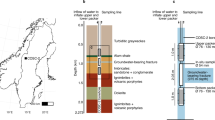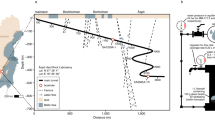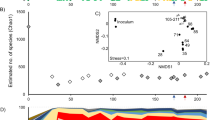Abstract
As part of an effort to diagnose the physiological status of Geobacter species during in situ bioremediation of uranium-contaminated groundwater, transcript levels for two genes potentially associated with oxidative stress, cydA and sodA, were quantified throughout a bioremediation field study in Rifle, CO, USA. Despite the accumulation of Fe(II) in the groundwater, which is inconsistent with the presence of dissolved oxygen, both genes were highly expressed during the bioremediation process. Therefore, the response to oxidative stress was further evaluated with Geobacter uraniireducens, an isolate from the Rifle site. When G. uraniireducens cultured with fumarate as the electron acceptor was exposed to 5% oxygen for 8 h, there was a significant increase in cydA and sodA transcripts as well as other genes associated with oxygen respiration or oxidative stress. Oxygen-exposed cells had lower transcript abundance for genes associated with anaerobic respiration, metabolism and motility. Short-term oxygen exposure had little impact on cydA transcript levels, as more than 1 h was required for increases to levels comparable to the subsurface. Abundance of cydA and sodA transcripts for the isolate G. sulfurreducens were always higher in cells cultured with Fe(III) compared with fumarate as an electron acceptor, even when fumarate-grown cells were exposed to oxygen, and Fe(III)-grown cells were grown anaerobically. These results suggest that the apparently high Geobacter cydA and sodA expression during bioremediation cannot necessarily be attributed to oxidative stress and demonstrate that diagnosis of the metabolic status of subsurface microorganisms through transcript analysis should be coupled with appropriate geochemical analyses.
Similar content being viewed by others
Log in or create a free account to read this content
Gain free access to this article, as well as selected content from this journal and more on nature.com
or
Accession codes
References
Anderson RT, Lovley DR . (1997). Ecology and biogeochemistry of in situ groundwater bioremediation. In: Jones (ed). Advances in Microbial Ecology, vol. 15. Plenum Press: New York, pp 289–350.
Anderson RT, Vrionis HA, Ortiz-Bernad I, Resch CT, Long PE, Dayvault R et al. (2003). Stimulating the in situ activity of Geobacter species to remove uranium from the groundwater of a uranium-contaminated aquifer. Appl Environ Microbiol 69: 5884–5891.
Balch WE, Wolfe RS . (1979). Specificity and biological distribution of coenzyme M (2-mercaptoethanesulfonic acid). J Bacteriol 137: 256–263.
Beliaev AS, Klingeman DM, Klappenbach JA, Wu L, Romine MF, Tiedje JA et al. (2005). Global transcriptome analysis of Shewanella oneidensis MR-1 exposed to different terminal electron acceptors. J Bacteriol 187: 7138–7145.
Brumlik MJ, Voordouw G . (1989). Analysis of the transcriptional unit encoding the genes for rubredoxin (Rub) and a putative rubredoxin oxidoreductase (Rbo) in Desulfovibrio vulgaris Hildenborough. J Bacteriol 171: 4996–5004.
Chin KJ, Esteve-Nunez A, Leang C, Lovley DR . (2004). Direct correlation between rates of anaerobic respiration and levels of mRNA for key respiratory genes in Geobacter sulfurreducens. Appl Environ Microbiol 70: 5183–5189.
Cypionka H . (2000). Oxygen respiration by Desulfovibrio species. Annu Rev Microbiol 54: 827–848.
Das A, Silaghi-Dumitrescu R, Ljungdahl LG, Kurtz DM . (2005). Cytochrome bd oxidase, oxidative stress, and dioxygen tolerance of the strictly anaerobic bacterium Moorella thermoacetica. J Bacteriol 187: 2020–2029.
Edwards L, Kusel K, Drake H, Kostka JE . (2007). Electron flow in acidic subsurface sediments co-contaminated with nitrate and uranium. Geochim Cosmochim Acta 71: 643–654.
Ellis DE, Lutz EJ, Odom JM, Buchanan RJ, Bartlett CL, Lee MD et al. (2000). Bioaugmentation for accelerated in situ anaerobic bioremediation. Environ Sci Technol 34: 2254–2260.
Esteve-Nunez A, Rothermich M, Sharma M, Lovley D . (2005). Growth of Geobacter sulfurreducens under nutrient-limiting conditions in continuous culture. Environ Microbiol 7: 641–648.
Fareleira P, Santos BS, Antonio C, Moradas-Ferreira P, LeGall J, Xavier AV et al. (2003). Response of a strict anaerobe to oxygen: survival strategies in Desulfovibrio gigas. Microbiology 149: 1513–1522.
Finneran KT, Anderson RT, Nevin KP, Lovley DR . (2002). Potential for bioremediation of uranium-contaminated aquifers with microbial U(VI) reduction. Soil Sediment Contamin 11: 339–357.
Fleming JT, Sanseverino J, Sayler GS . (1993). Quantitative relationship between naphthalene catabolic gene-frequency and expression in predicting PAH degradation in soils at town gas manufacturing sites. Environ Sci Technol 27: 1068–1074.
Hazen TC, Stahl DA . (2006). Using the stress response to monitor process control: pathways to more effective bioremediation. Curr Opin Biotechnol 17: 285–290.
He J, Sung Y, Krajmalnik-Brown R, Ritalahti KM, Loffler FE . (2005). Isolation and characterization of Dehalococcoides sp strain FL2, a trichloroethene (TCE)- and 1,2-dichloroethene-respiring anaerobe. Environ Microbiol 7: 1442–1450.
Heidelberg JF, Seshadri R, Haveman SA, Hemme CL, Paulsen IT, Kolonay JF et al. (2004). The genome sequence of the anaerobic, sulfate-reducing bacterium Desulfovibrio vulgaris Hildenborough. Nat Biotechnol 22: 554–559.
Holmes DE, Chaudhuri SK, Nevin KP, Mehta T, Methe BA, Liu A et al. (2006). Microarray and genetic analysis of electron transfer to electrodes in Geobacter sulfurreducens. Environ Microbiol 8: 1805–1815.
Holmes DE, Nevin KP, Lovley DR . (2004). In situ expression of nifD in Geobacteraceae in subsurface sediments. Appl Environ Microbiol 70: 7251–7259.
Holmes DE, Nevin KP, O'Neil RA, Ward JE, Adams LA, Woodard TL et al. (2005). Potential for quantifying expression of the Geobacteraceae citrate synthase gene to assess the activity of Geobacteraceae in the subsurface and on current-harvesting electrodes. Appl Environ Microbiol 71: 6870–6877.
Holmes DE, O'Neil RA, Chavan MA, N'Guessan LA, Vrionis HA, Perpetua LA et al. (2008). Transcriptome of Geobacter uraniireducens growing in uranium-contaminated subsurface sediments. ISME J; e-pub ahead of print 9 October 2008; doi:10.1038/ismej.2008.89.
Holmes DE, O'Neil RA, Vrionis HA, N'Guessan LA, Ortiz-Bernad I, Larrahondo MJ et al. (2007). Subsurface clade of Geobacteraceae that predominates in a diversity of Fe(III)-reducing subsurface environments. ISME J 1: 663–677.
Imlay JA . (2003). Pathways of oxidative damage. Annu Rev Microbiol 57: 395–418.
Imlay JA, Linn S . (1988). DNA damage and oxygen radical toxicity. Science 240: 1302–1309.
Istok JD, Senko JM, Krumholz LR, Watson D, Bogle MA, Peacock A et al. (2004). In situ bioreduction of technetium and uranium in a nitrate-contaminated aquifer. Environ Sci Technol 38: 468–475.
Jenney FE, Verhagen M, Cui XY, Adams MWW . (1999). Anaerobic microbes: oxygen detoxification without superoxide dismutase. Science 286: 306–309.
Johnson DR, Lee PKH, Holmes VF, Fortin AC, Alvarez-Cohen L . (2005). Transcriptional expression of the tceA gene in a Dehalococcoides-containing microbial enrichment. Appl Environ Microbiol 71: 7145–7151.
Keyer K, Imlay JA . (1996). Superoxide accelerates DNA damage by elevating free-iron levels. Proc Natl Acad Sci USA 93: 13635–13640.
Krekeler D, Teske A, Cypionka H . (1998). Strategies of sulfate-reducing bacteria to escape oxygen stress in a cyanobacterial mat. FEMS Microbiol Ecol 25: 89–96.
Kurtz DM . (2006). Avoiding high-valent iron intermediates: superoxide reductase and rubrerythrin. J Inorg Biochem 100: 679–693.
Lee PKH, Johnson DR, Holmes VF, He JZ, Alvarez-Cohen L . (2006). Reductive dehalogenase gene expression as a biomarker for physiological activity of Dehalococcoides spp. Appl Environ Microbiol 72: 6161–6168.
Lin WC, Coppi MV, Lovley DR . (2004). Geobacter sulfurreducens can grow with oxygen as a terminal electron acceptor. Appl Environ Microbiol 70: 2525–2528.
Lobo SAL, Melo AMP, Carita JN, Teixeira M, Saraiva LM . (2007). The anaerobe Desulfovibrio desulfuricans ATCC 27774 grows at nearly atmospheric oxygen levels. FEBS Lett 581: 433–436.
Lovley DR . (2003). Cleaning up with genomics: applying molecular biology to bioremediation. Nat Rev Microbiol 1: 35–44.
Lovley DR, Phillips EJP . (1986). Organic-matter mineralization with reduction of ferric iron in anaerobic sediments. Appl Environ Microbiol 51: 683–689.
Lowson RT . (1982). Aqueous oxidation of pyrite by molecular-oxygen. Chem Rev 82: 461–497.
Machado P, Felix R, Rodrigues R, Oliveira S, Rodrigues-Pousada C . (2006). Characterization and expression analysis of the cytochrome bd oxidase operon from Desulfovibrio gigas. Curr Microbiol 52: 274–281.
Methe BA, Nelson KE, Eisen JA, Paulsen IT, Nelson W, Heidelberg JF et al. (2003). Genome of Geobacter sulfurreducens: metal reduction in subsurface environments. Science 302: 1967–1969.
Methe BA, Webster J, Nevin K, Butler J, Lovley DR . (2005). DNA microarray analysis of nitrogen fixation and Fe(III) reduction in Geobacter sulfurreducens. Appl Environ Microbiol 71: 2530–2538.
Morgan B, Lahav O . (2007). The effect of pH on the kinetics of spontaneous Fe(II) oxidation by O-2 in aqueous solution—basic principles and a simple heuristic description. Chemosphere 68: 2080–2084.
Moser DP, Nealson KH . (1996). Growth of the facultative anaerobe Shewanella putrefaciens by elemental sulfur reduction. Appl Environ Microbiol 62: 2100–2105.
Mukhopadhyay A, Redding AM, Joachimiak MP, Arkin A, Borglin SC, Dehal PS et al. (2007). Cell-wide responses to low-oxygen exposure in Desulfovibrio vulgaris Hildenborough. J Bacteriol 189: 5996–6010.
North NN, Dollhopf SL, Petrie L, Istok JD, Balkwill DL, Kostka JE . (2004). Change in bacterial community structure during in situ biostimulation of subsurface sediment cocontaminated with uranium and nitrate. Appl Environ Microbiol 70: 4911–4920.
O'Neil RA, Holmes DE, Coppi MV, Adams LA, Larrahondo MJ, Ward JE et al. (2008). Gene transcript analysis of assimilatory iron limitation in Geobacteraceae during groundwater bioremediation. Environ Microbiol 10: 1218–1230.
Parro V, Moreno-Paz M, Gonzalez-Toril E . (2007). Analysis of environmental transcriptomes by DNA microarrays. Environ Microbiol 9: 453–464.
Postier B, DiDonato RJ, Nevin KP, Liu A, Frank B, Lovley D et al. (2008). Benefits of in-situ synthesized microarrays for analysis of gene expression in understudied microorganisms. J Microbiol Methods 74: 26–32.
Rahm BG, Richardson RE . (2008). Correlation of respiratory gene expression levels and pseudo-steady-state PCE respiration rates in Dehalococcoides ethenogenes. Environ Sci Technol 42: 416–421.
Röling WFM, van Verseveld HW . (2002). Natural attenuation: what does the subsurface have in store? Biodegradation 13: 53–64.
Saleh-Lakha S, Miller M, Campbell RG, Schneider K, Elahimanesh P, Hart MM et al. (2005). Microbial gene expression in soil: methods, applications and challenges. J Microbiol Methods 63: 1–19.
Shelobolina ES, Vrionis HA, Findlay RH, Lovley DR . (2008). Geobacter uraniireducens sp. nov., isolated from subsurface sediment undergoing uranium bioremediation. Int J Syst Evol Microbiol 58: 1075–1078.
Silva G, Oliveira S, Gomes CM, Pacheco I, Liu MY, Xavier AV et al. (1999). Desulfovibrio gigas neelaredoxin—a novel superoxide dismutase integrated in a putative oxygen sensory operon of an anaerobe. Eur J Biochem 259: 235–243.
Smyth GK, Michaud J, Scott HS . (2005). Use of within-array replicate spots for assessing differential expression in microarray experiments. Bioinformatics 21: 2067–2075.
Smyth GK, Speed T . (2003). Normalization of cDNA microarray data. Methods 31: 265–273.
Voordouw JK, Voordouw G . (1998). Deletion of the rbo gene increases the oxygen sensitivity of the sulfate-reducing bacterium Desulfovibrio vulgaris Hildenborough. Appl Environ Microbiol 64: 2882–2887.
Acknowledgements
This research was supported by the Office of Science Biological and Environmental Research (BER), US Department of Energy, Grant no. DE-FG02-07ER64377.
Author information
Authors and Affiliations
Corresponding author
Additional information
Supplementary Information accompanies the paper on The ISME Journal website (http://www.nature.com/ismej)
Supplementary information
Rights and permissions
About this article
Cite this article
Mouser, P., Holmes, D., Perpetua, L. et al. Quantifying expression of Geobacter spp. oxidative stress genes in pure culture and during in situ uranium bioremediation. ISME J 3, 454–465 (2009). https://doi.org/10.1038/ismej.2008.126
Received:
Revised:
Accepted:
Published:
Issue date:
DOI: https://doi.org/10.1038/ismej.2008.126
Keywords
This article is cited by
-
Comparative insights into genome signatures of ferric iron oxide- and anode-stimulated Desulfuromonas spp. strains
BMC Genomics (2021)
-
Transient O2 pulses direct Fe crystallinity and Fe(III)-reducer gene expression within a soil microbiome
Microbiome (2018)
-
Evidence of Geobacter-associated phage in a uranium-contaminated aquifer
The ISME Journal (2015)
-
Relating mRNA and protein biomarker levels in a Dehalococcoides and Methanospirillum-containing community
Applied Microbiology and Biotechnology (2015)
-
Characterization and transcription of arsenic respiration and resistance genes during in situ uranium bioremediation
The ISME Journal (2013)



